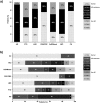Testing the 2018 NIA-AA research framework in a retrospective large cohort of patients with cognitive impairment: from biological biomarkers to clinical syndromes
- PMID: 31615545
- PMCID: PMC6794758
- DOI: 10.1186/s13195-019-0543-7
Testing the 2018 NIA-AA research framework in a retrospective large cohort of patients with cognitive impairment: from biological biomarkers to clinical syndromes
Abstract
Background: According to the 2018 NIA-AA research framework, Alzheimer's disease (AD) is not defined by the clinical consequences of the disease, but by its underlying pathology, measured by biomarkers. Evidence of both amyloid-β (Aβ) and phosphorylated tau protein (p-tau) deposition-assessed interchangeably with amyloid-positron emission tomography (PET) and/or cerebrospinal fluid (CSF) analysis-is needed to diagnose AD in a living person. Our aim was to test the new NIA-AA research framework in a large cohort of cognitively impaired patients to evaluate correspondence between the clinical syndromes and the underlying pathologic process testified by biomarkers.
Methods: We retrospectively analysed 628 subjects referred to our centre in suspicion of dementia, who underwent CSF analysis, together with neuropsychological assessment and neuroimaging, and were diagnosed with different neurodegenerative dementias according to current criteria, or as cognitively unimpaired. Subjects were classified considering CSF biomarkers, and the prevalence of normal, AD-continuum and non-AD profiles in each clinical syndrome was calculated. The positivity threshold of each CSF biomarker was first assessed by receiver operating characteristic analysis, using Aβ-positive/negative status as determined by amyloid-PET visual reads. The agreement between CSF and amyloid-PET data was also evaluated.
Results: Among patients with a clinical diagnosis of AD, 94.1% were in the AD-continuum, whereas 5.5% were classified as non-AD and 0.4% were normal. The AD-continuum profile was found also in 26.2% of frontotemporal dementia, 48.6% of Lewy body dementia, 25% of atypical parkinsonism and 44.7% of vascular dementia. Biomarkers' profile did not differ in amnestic and not amnestic mild cognitive impairment. CSF Aβ levels and amyloid-PET tracer binding negatively correlated, and the concordance between the two Aβ biomarkers was 89%.
Conclusions: The examination of the 2018 NIA-AA research framework in our clinical setting revealed a good, but incomplete, correspondence between the clinical syndromes and the underlying pathologic process measured by CSF biomarkers. The AD-continuum profile resulted to be a sensitive, but non-specific biomarker with regard to the clinical AD diagnosis. CSF and PET Aβ biomarkers were found to be not perfectly interchangeable to quantify the Aβ burden, possibly because they measure different aspects of AD pathology.
Keywords: Alzheimer’s disease; Biomarkers; CSF; Clinical neurology; Dementia; PET.
Conflict of interest statement
The authors declare that they have no competing interests.
Figures



References
-
- McKhann Guy M., Knopman David S., Chertkow Howard, Hyman Bradley T., Jack Clifford R., Kawas Claudia H., Klunk William E., Koroshetz Walter J., Manly Jennifer J., Mayeux Richard, Mohs Richard C., Morris John C., Rossor Martin N., Scheltens Philip, Carrillo Maria C., Thies Bill, Weintraub Sandra, Phelps Creighton H. The diagnosis of dementia due to Alzheimer’s disease: Recommendations from the National Institute on Aging-Alzheimer’s Association workgroups on diagnostic guidelines for Alzheimer's disease. Alzheimer's & Dementia. 2011;7(3):263–269. doi: 10.1016/j.jalz.2011.03.005. - DOI - PMC - PubMed
-
- Jack Clifford R., Bennett David A., Blennow Kaj, Carrillo Maria C., Dunn Billy, Haeberlein Samantha Budd, Holtzman David M., Jagust William, Jessen Frank, Karlawish Jason, Liu Enchi, Molinuevo Jose Luis, Montine Thomas, Phelps Creighton, Rankin Katherine P., Rowe Christopher C., Scheltens Philip, Siemers Eric, Snyder Heather M., Sperling Reisa, Elliott Cerise, Masliah Eliezer, Ryan Laurie, Silverberg Nina. NIA-AA Research Framework: Toward a biological definition of Alzheimer's disease. Alzheimer's & Dementia. 2018;14(4):535–562. doi: 10.1016/j.jalz.2018.02.018. - DOI - PMC - PubMed
-
- Jack Clifford R., Bennett David A., Blennow Kaj, Carrillo Maria C., Feldman Howard H., Frisoni Giovanni B., Hampel Harald, Jagust William J., Johnson Keith A., Knopman David S., Petersen Ronald C., Scheltens Philip, Sperling Reisa A., Dubois Bruno. A/T/N: An unbiased descriptive classification scheme for Alzheimer disease biomarkers. Neurology. 2016;87(5):539–547. doi: 10.1212/WNL.0000000000002923. - DOI - PMC - PubMed

